Physical Address
304 North Cardinal St.
Dorchester Center, MA 02124
There is a significant association between cervix length and the risk of preterm birth.
A cervical length of more than 3 cm has a high negative predictive value for delivery at less than 34 weeks' gestation.
The most reliable method of documenting cervical length is transvaginal ultrasound.
The single most reliable parameter for cervical assessment is a short cervical length.
The earlier in gestation, the shorter the cervix, the greater is the risk of spontaneous preterm birth before 34 weeks, with the best predictive value when cervical length measures less than 25 mm.
Rate of cervical change may be a better predictor than cervical length.
Preterm birth (PTB), defined as delivery before 37 weeks of gestation, occurs in 5% to 11% of all pregnancies, ranging from as low as 5% in some European countries to 15% in the United States and to as high as 18% in some African countries, attributable to geographic, socioeconomic, and racial disparities. PTB is the leading cause of neonatal morbidity and mortality not attributable to congenital anomalies or aneuploidy. If an infant is born preterm, the risk of death in the first year of life is 40-fold greater compared with an infant born at term.
Immediate consequences of PTB include respiratory distress, intraventricular hemorrhage, sepsis, and retinopathy of prematurity. In the long term, infants born preterm represent one-half the children with cerebral palsy, one-third of those with abnormal vision, one-quarter of those with chronic lung disease, and one-fifth of children with mental retardation. The morbidity of prematurity persists to adulthood, with an increased incidence of behavioral problems, lower levels of educational achievement, reduced rates of reproductive success (with incidence of both conception and live birth adversely affected), and an increased incidence of second-generation PTB.
The risk of prematurity persists in subsequent pregnancies, with a twofold increased risk in the next pregnancy and up to 50% risk of PTB if the woman has experienced two or more prior PTBs. Given the substantial and far-reaching impact of PTB, it is important to recognize patients at increased risk of spontaneous preterm birth (SPTB), such that therapeutic interventions can be implemented to improve neonatal outcome.
About 85% of preterm deliveries occur spontaneously and are traditionally classified as one of three discrete events: preterm labor (uterine activity with coordinated cervical effacement and dilation), preterm premature ruptured membranes (ruptured fetal membranes in the absence of uterine activity and cervical change), or cervical incompetence (cervical dilation in the absence of uterine activity). Cervical incompetence can be further defined as either a mechanical failure of the cervix to remain closed against the increasing intrauterine expansion or as a functional failure, with premature activation of the events of cervical ripening (dilation and effacement) that normally occur at term. Although categorized in this manner, spontaneous premature delivery is best described along a continuum of biologic events leading to early delivery, given that the biochemical mediators that effect uterine contractions, fetal membrane disruption, and cervical ripening are similar: prostaglandins, the metallomatrix proteases and their inhibitors, and the families of proinflammatory and antiinflammatory cytokines. As such, the events of prematurity often overlap; in particular, cervical change can precede fetal membrane rupture and uterine contractions, although the cervix may not be functionally or mechanically incompetent.
Evaluation of the cervix has been used as a tool to predict SPTB based on the concept that the cervix acts as an anatomic marker of the underlying pathologic processes leading to a premature delivery. Digital examination of the cervix measures only the length from the external cervical os to the cervical-vaginal junction, not the intrapelvic cervical-isthmus portion of the cervix. Therefore digital examination underestimates cervical length by a mean difference of 12 mm in more than 80% of women in the second and third trimesters compared with sonography. Moreover, dilation of the cervix starts proximally so the distal portion may still appear normal on digital exam, even when the cervix has started to shorten and/or dilate. The current approach to evaluation of the cervix is by ultrasound, preferably via the transvaginal route. This chapter reviews the techniques of uterine cervix sonography and its relationship with PTB prediction.
There are three approaches to scanning the cervix: transabdominal sonography (TAS), transvaginal sonography (TVS) and transperineal (translabial) sonography. Each approach has advantages and limitations for different clinical scenarios. The closed length of the cervix is the single most important parameter to report, as it is most closely linked to the risk of PTB. Additional comments include any evidence of funneling.
TAS of the cervix is typically performed during the standard second- and third-trimester obstetric ultrasound examinations and is used as a routine screening tool for measurement of closed cervical length.
Longitudinal scanning is initiated in the midline of the lower abdomen, just above the symphysis pubis, using a transducer with a frequency of 3 MHz or higher. Landmarks include the internal cervical os, the external cervical os, the outline of the cervical canal, and the outline of the cervical corpus ( Fig. 44.1 ). Measurement of cervical length is affected by overdistention of the urinary bladder. Increased bladder pressure can compress the lower uterine segment and falsely elongate the cervix or mask cervical dilation. Cervices less than 2 cm in length cannot be easily visualized against the vaginal and bladder tissue.
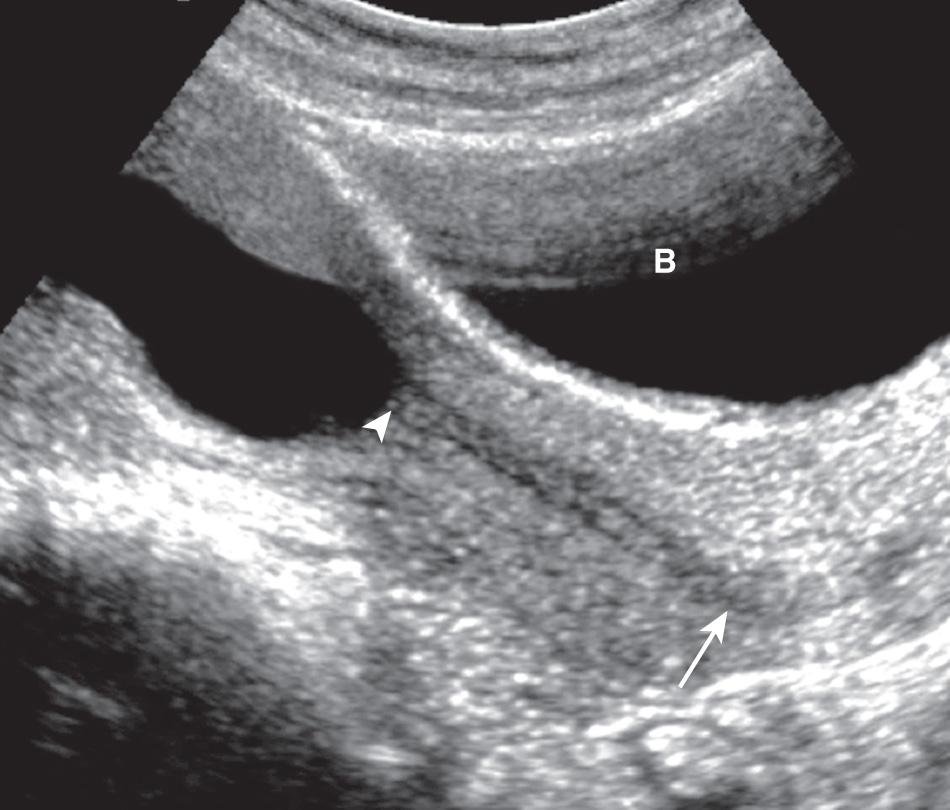
In the second trimester, if the urinary bladder is empty, amniotic fluid can be used as an acoustic window to scan the cervix. Longitudinal scans are obtained with the transducer angled downward from just below the umbilicus. The cervix may assume a more vertical orientation and appear bulkier ( Fig. 44.2 ) when the bladder is empty. Difficulty in identifying the external os can contribute to error in cervical length measurement.
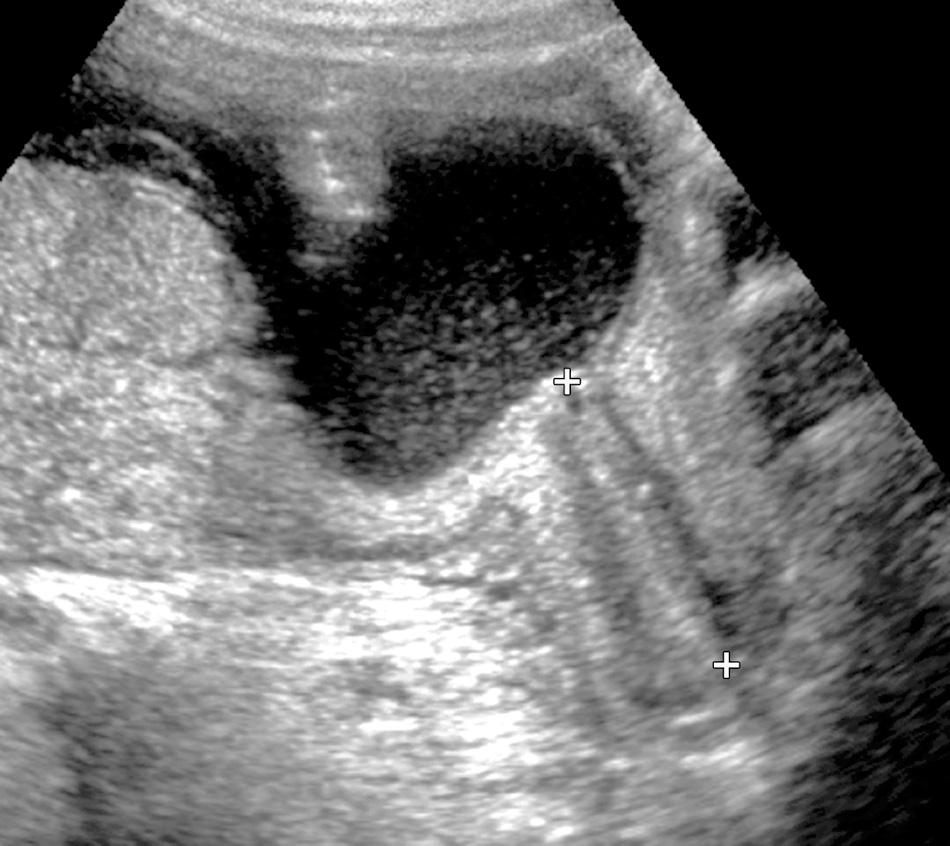
Visualization of the cervix can be difficult because of large maternal habitus or an engaged position of the fetal head. Regardless of the gestational age, there is relatively poor reproducibility of TAS measurement of the cervix. Research has demonstrated conflicting results regarding the usefulness of TAS screens in that the cutoff in TAS to identify a cervix length of 25 mm or less is variable. This suggests that higher TAS cutoffs are required to achieve high sensitivity. The challenge is that in a low-risk group, the prevalence of short cervix due to cervical incompetence is low and a large sample size is required to achieve meaningful statistics.
Transperineal sonography is reserved for patients for whom the cervix cannot be adequately visualized by TAS, and in whom TVS is unacceptable for personal or discomfort-related concerns. Scanning is performed with an empty urinary bladder. An abdominal transducer with a frequency of 3 MHz or higher can be used. To minimize the risk of transmission of infection, the transducer is covered with plastic wrap. With the patient supine and hips abducted, the transducer is placed between the labia minora at the vaginal introitus. The ultrasound beam is oriented in a sagittal plane along the direction of the vagina. The vagina is seen in a vertical plane between the bladder and the rectum ( Fig. 44.3 ). The cervix is oriented horizontally, at a right angle with the vagina. The full length of the cervical canal can be visualized in 86% to 96% of patients with this technique ; however, in some cases the region of the external os can be obscured by rectal gas or the symphysis pubis. Although some reports have suggested that the reproducibility of the measurements is poor, others have demonstrated improved reproducibility and accuracy in the hands of an experienced examiner. This enhanced requirement for experience limits the utility of this study. This examination has a greater learning curve in order to perform reliably and reproducibly than TVS studies. Cicero et al. showed that 50% of transperineal studies were inadequate because of shadowing in the learning phase of the first 200 patients. Subsequently in the second phase reliable images were obtained in 78% of cases. Because transperineal scanning of the cervix is more dependent on gestational age and the experience of the investigator, it should be reserved as an alternative study in patients for whom a TVS is deemed unacceptable for psychological, cultural, or medical reasons.
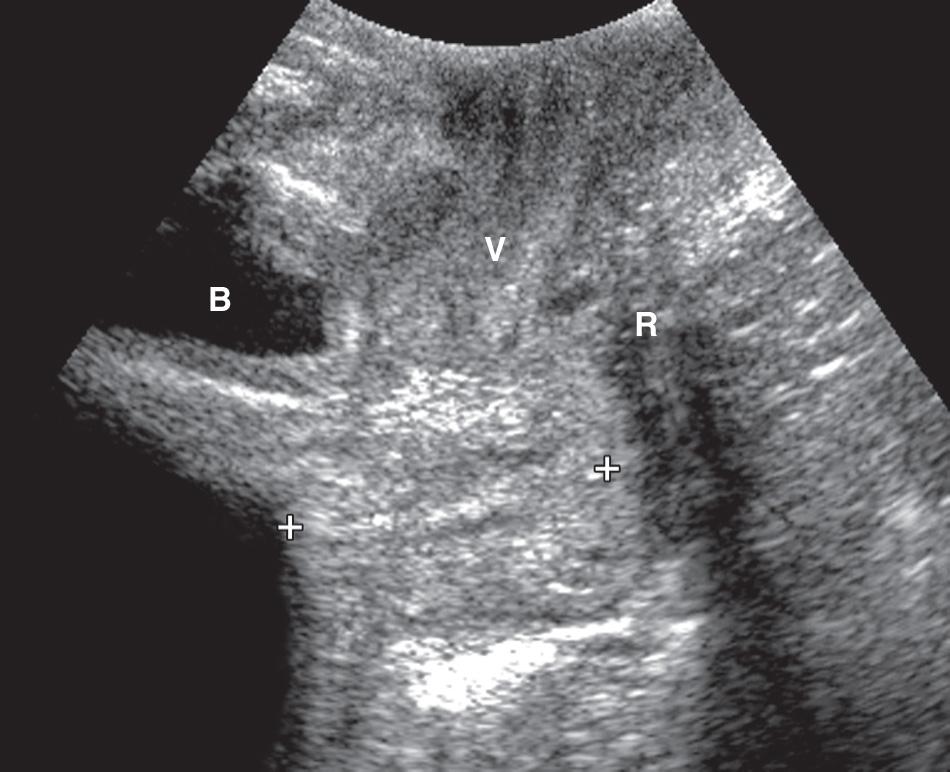
TVS is the reference-standard technique for accurate determination of the dimensions and characteristics of the cervix. The examination is performed with an empty urinary bladder. A gynecologic table fitted with stirrups is preferred, although the examination can be carried out with the patient's hips elevated on a thick cushion or wedge. With the patient in a dorsal lithotomy position, supine and hips abducted, an endovaginal transducer (5-MHz or higher frequency) covered with plastic wrap is placed in the vagina and oriented in a longitudinal plane. The probe is inserted under real-time visualization until the cervix comes into view. Usually, the transducer is inserted only 3 to 4 cm into the vagina so that the images of the cervix are within the effective focal range of the transducer ( Fig. 44.4 ). Depending on the position of the cervix in the vagina, the probe may need to be moved anteriorly, posteriorly, and/or laterally. There is a standardized method for obtaining reproducible cervical measurements (see box).
Place the probe in the anterior fornix of the vagina.
Obtain a sagittal view of the cervix, with the long-axis view of echogenic endocervical mucosa along the length of the canal.
Withdraw the probe until the image is blurred, and reapply just enough pressure to restore the image (to avoid excessive pressure on the cervix, which can elongate it).
Enlarge the image so that the cervix occupies at least two-thirds of the image and external and internal os are well seen.
Measure the cervical length from the internal to the external os along the endocervical canal.
Obtain at least three measurements, and record the shortest best measurement in millimeters.
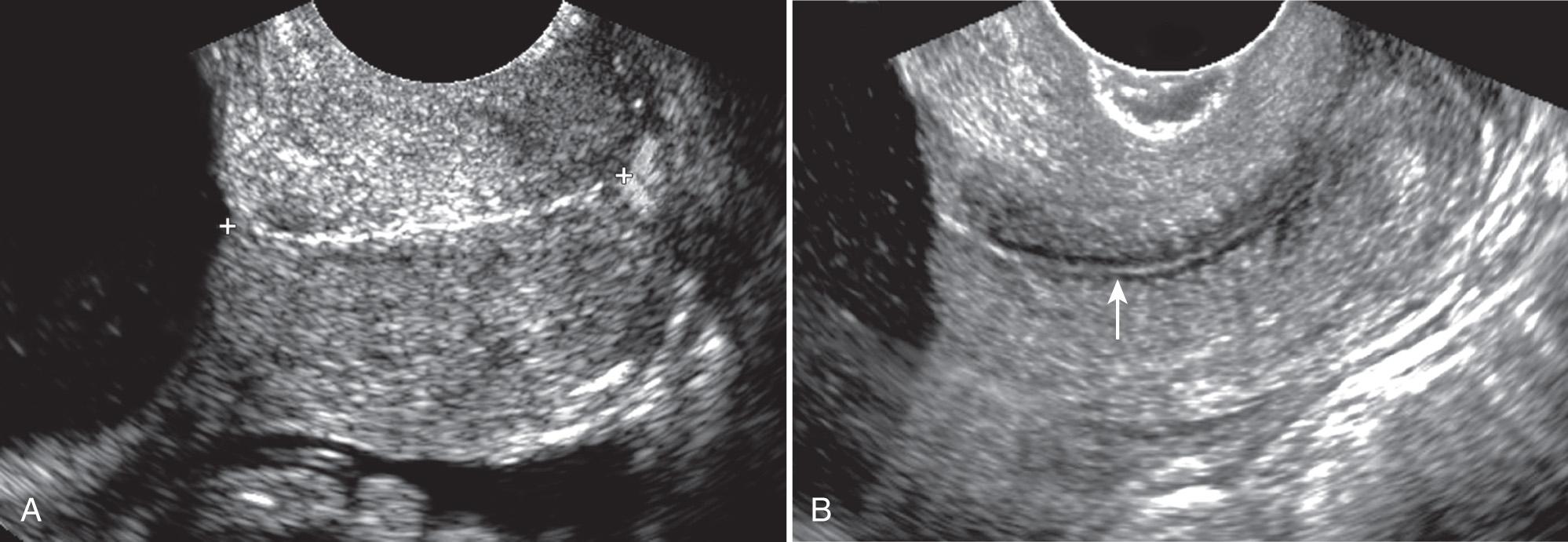
A symmetrical image of the external os should be obtained, and the distance from the surface of the anterior lip to the cervical canal should be equal to the distance from the surface of the posterior lip to the cervical canal. If the anterior lip appears thinner than the posterior lip, there may be undue pressure placed on the cervix by the transvaginal probe. An additional sign of excessive pressure is increased echogenicity of the cervix ( Fig. 44.5 ).

When the cervix appears curved (deviation of the central canal of >5 mm from a straight line connecting the external and internal os), the cervical length can be either traced or the sum of two straight lines that follow the curve can be used. Using these standard criteria, the interobserver coefficient of variation can be improved to 3.3%.
TVS is superior to the TAS technique. Higher-frequency transducers and closer proximity to the structures studied allow for better resolution. Potential complications of TVS include an increased risk of bleeding in the presence of placenta previa, induction of uterine activity in women with cervical shortening caused by cervical stimulation, and chorioamnionitis in the presence of ruptured membranes. However, increased risk of chorioamnionitis or neonatal sepsis with TVS after preterm premature rupture of membranes (PPROM) has not been demonstrated. TVS has also been deemed safe to use in patients with placenta previa with no increased risk for bleeding; however, caution is advised to ensure that the probe is always carefully inserted under real-time visualization.
To date, TVS assessment of cervical length by three-dimensional sonography has been limited to the development of a normal distribution curve of cervical length through gestation. Overall, mean cervical length appears to be longer than the measurement by traditional two-dimensional scanning. However, there is to be high intra/interobserver variability. Currently, there are no reported studies of the relationship between three-dimensional TVS and SPTB prediction.
As mentioned previously, one limitation of TAS, especially in advanced gestation, is that the cervix may be obscured by the presenting part, in particular with a cephalic presentation. In addition, a short cervix or empty bladder may reduce the quality of the measurement obtained, whereas a full bladder may artificially elongate the cervix.
There are a number of technical limitations and pitfalls associated with TVS of the cervix. Large maternal body habitus can limit visualization. Bowel gas can obscure visualization.
A lower uterine segment myometrial contraction, immediately superior to the cervix, may result in a pseudoelongation of the cervix ( Fig. 44.6 ). The classic tips to recognize this appearance is the artificially elongated length of the cervix (>5 cm), the thicker diameter of the “cervix” at the proximal extent, which actually incorporates the lower uterine muscle so that it appears thicker than at the external os. The thickness of the internal and external cervical os should be similar. Lower uterine segment contractions are transient and rarely persist beyond 15 minutes.
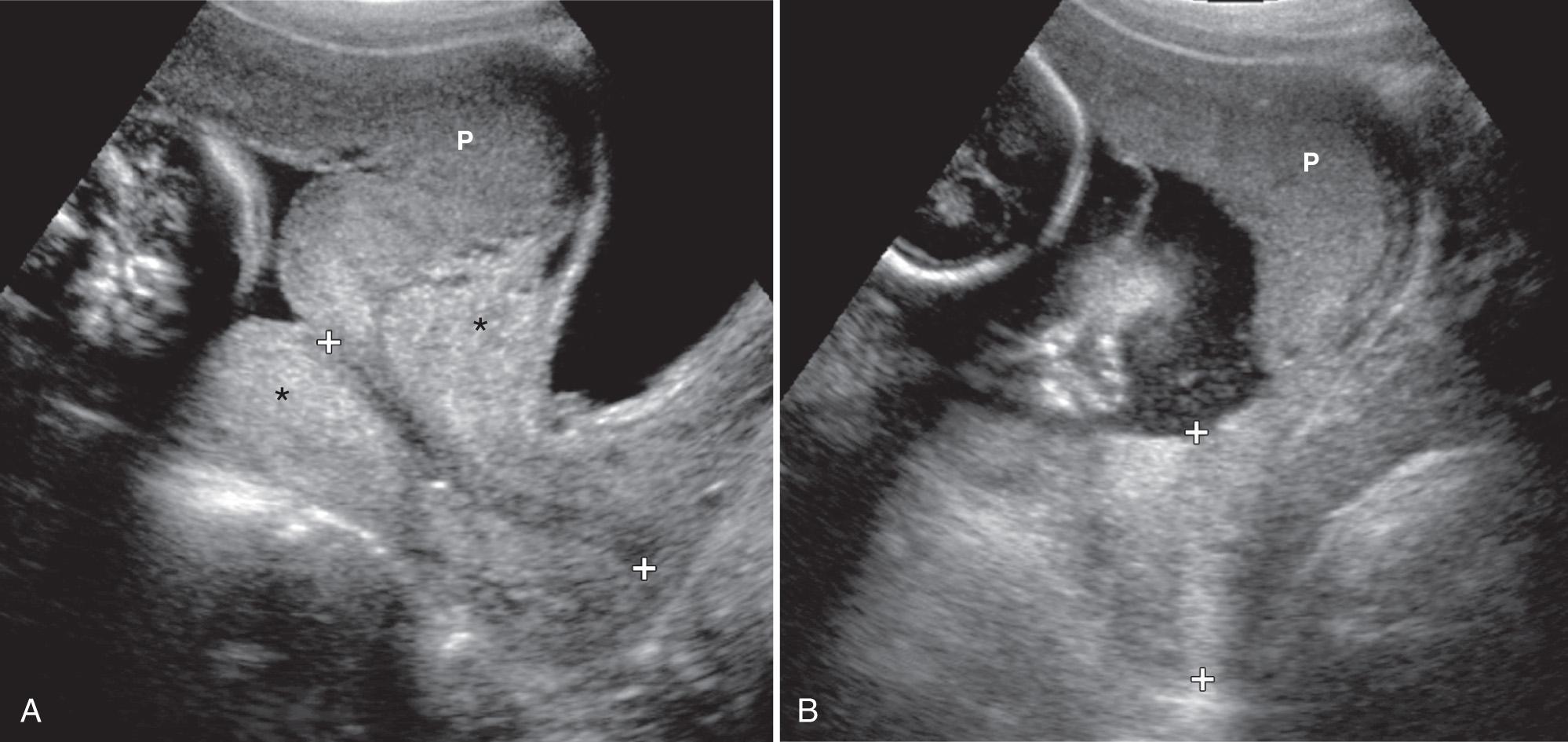
A second pitfall associated with the lower uterine segment contraction has been termed “pseudodilation” of the cervix. It is caused by a lower uterine segment contraction with partial ( Fig. 44.7 ) or complete approximation of the anterior and posterior myometrium with the resultant false appearance of a “funnel” above the closed cervix. The classic tips to recognize this appearance is the artificially elongated length of the cervix (>5 cm), the normal cervix lying caudal with respect to the pseudodilation, and the transient nature of this appearance.
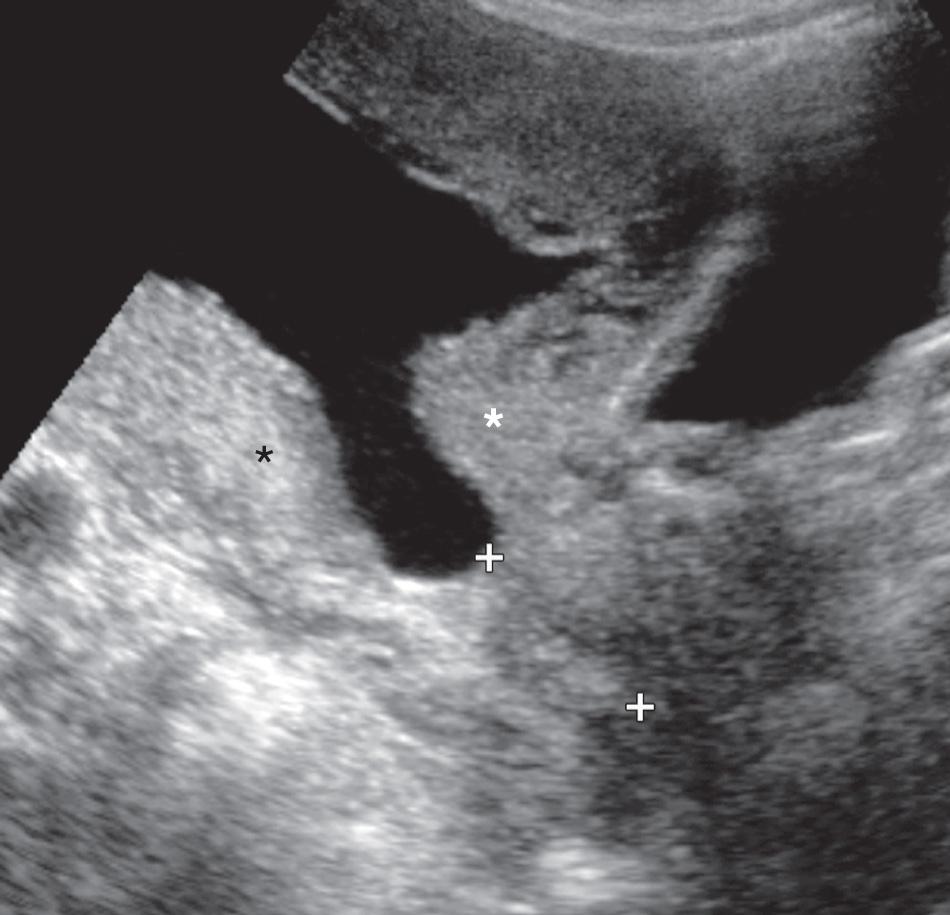
Sonographically, the cervix appears as a distinct, soft tissue structure containing midrange echoes. The endocervical canal often appears as an echogenic line surrounded by a hypoechoic zone attributed to the endocervical glands (see Fig. 44.4B ). Occasionally, the endocervical canal may appear hypoechoic and minimally dilated along its entire length. Benign nabothian cysts can be seen within the cervical soft tissues.
Numerous studies have evaluated cervical length in normal pregnancy. The typical cervix increases its length in the first trimester because of elaboration of the glandular content of the cervix. Salomon et al. published a reference curve of cervical length through gestation using TVS based on a large sample ( Fig. 44.8 ). Based on this study, at about 20 weeks' gestation, the 10th, 50th, and 90th percentiles of cervical length are 32.3, 41.9, and 50.5 mm, respectively. A progressive linear reduction in cervical length occurs over the 10th to 40th week of gestation.
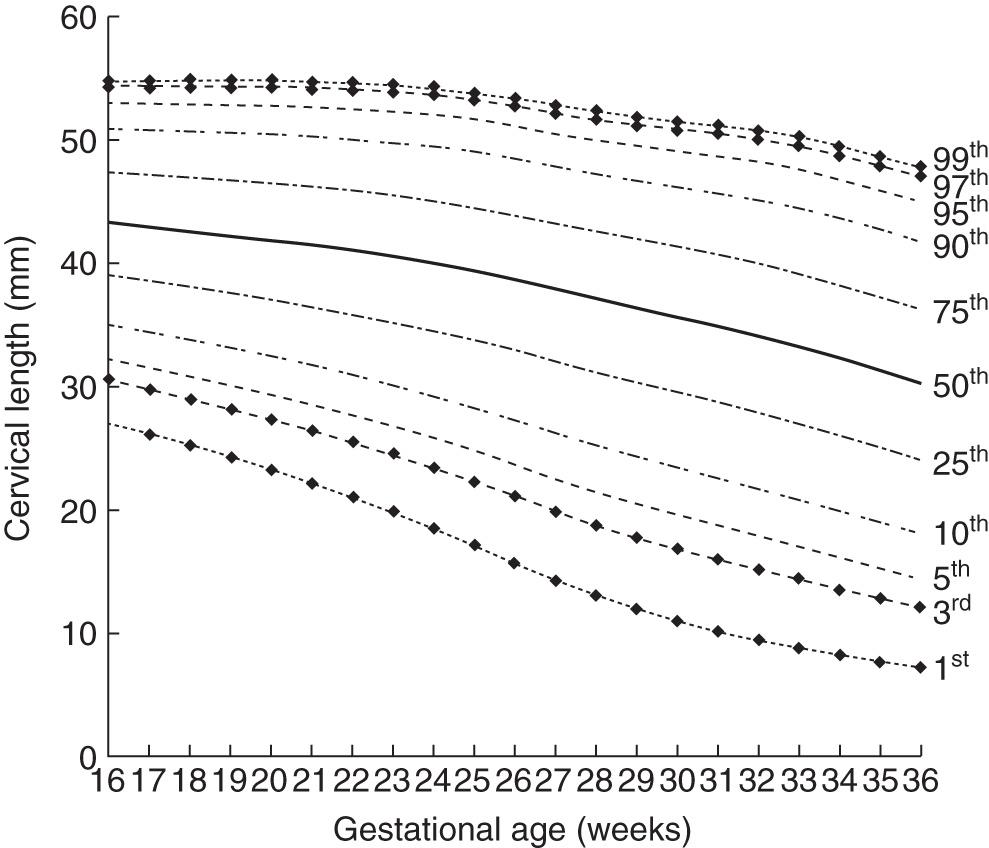
With the goal of understanding the relationship between cervical length and SPTB (delivery before 35 weeks' gestation), in 1996, Iams et al. published a prospective, multicenter study in which an unselected general population of women with singleton pregnancies underwent TVS at 24 and 28 weeks' gestation. Cervical length at both examinations was comparable and normally distributed, with a mean ±SD of 35.2 ± 8.3 mm at 24 weeks and 33.7 ± 8.5 mm at 28 weeks. A correlation between cervical length and the rate of SPTB was determined ( Fig. 44.9 ); if the cervix was less than 26 mm (10th percentile) or less than 13 mm (1st percentile), risk of SPTB was increased by 6.49-fold and 13.99-fold, respectively, compared with the rate of SPTB if the cervix was at the 75th percentile length (40 mm) or greater. Based on this landmark study, the definition of a “short cervix” as less than 25 mm (or <10th percentile length at 24-28 weeks) was accepted ( Fig. 44.10 ).
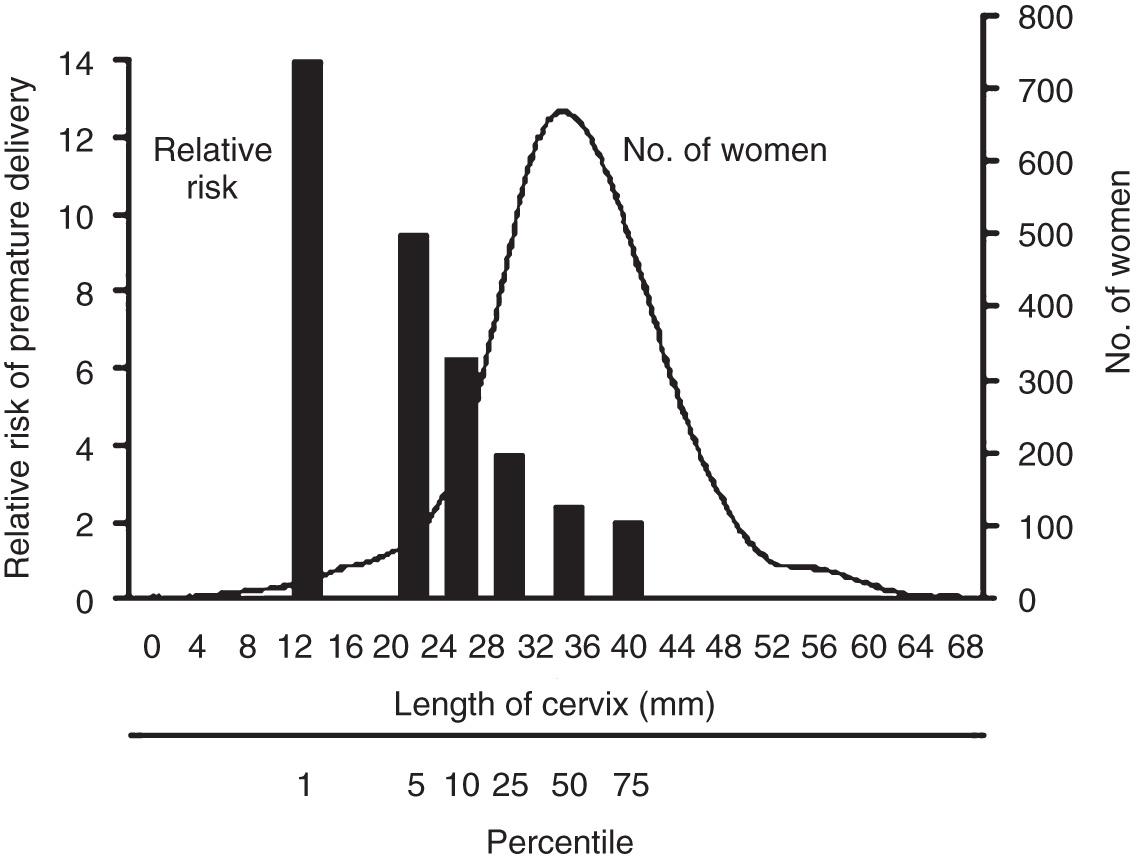
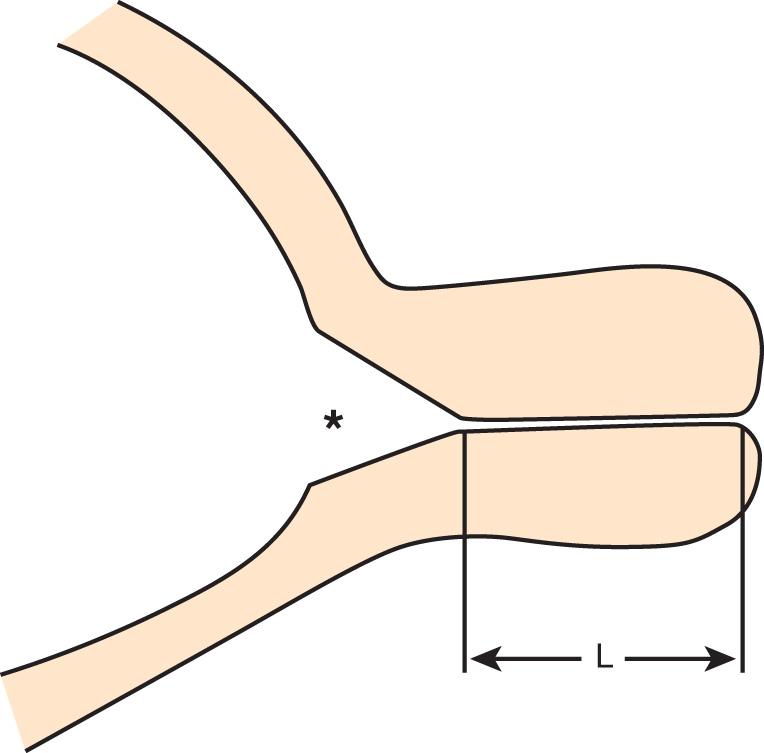
Since then, more than 50 studies of TVS evaluation of the cervix and the risk of SPTB have been published. In 2003, Honest et al. conducted a meta-analysis of 46 studies (including more than 31,000 asymptomatic singleton patients) and concluded that the utility of TVS assessment of cervical length for the prediction of SPTB varies with the gestational age at assessment and the definition of SPTB (birth before gestational age <32 weeks, <34 weeks, or <37 weeks). To summarize, the earlier in gestation, the shorter the cervix, the greater is the risk of SPTB, with the best predictive value when cervical length measures less than 25 mm and SPTB is defined as delivery earlier than 34 weeks' gestation ( Table 44.1 ).
| GA at Delivery | <20 Weeks | 20-24 Weeks | 24-28 Weeks |
|---|---|---|---|
| <32 weeks | 4.1 (1.6-10.1) | 4.19 (2.6-6.7) | No data |
| <34 weeks | 6.2 (3.2-12.0) | 4.40 (3.5-5.4) | 4.0 (3.1-5.2) |
| <37 weeks | 8.7 (3.8-19.9) | 25.6 (8.5-76.7) | 3.1 (1.1-8.9) |
a Data presented as odds ratio ±95th percentile confidence intervals.
However, it should be recognized that the previous studies assessed cervical length at or before 28 weeks' gestation. Several reports have demonstrated no predictive value of TVS measurement of the cervix beyond 30 weeks of gestation for any definition of SPTB, likely because the cervix undergoes a gradual shortening process beyond this gestational age regardless of the timing of delivery.
The controversial aspect of TVS assessment of cervical length and the prediction of SPTB is that not all patients with a defined “short” cervix at any gestational age will deliver preterm. TVS is a reasonable tool for identifying patients who will deliver at or close to term with good negative predictive value. However, more than 50% of patients with a cervical length less than 25 mm measured at 20 weeks will deliver beyond 34 weeks' gestation. Several studies have attempted to improve the predictive value of TVS by combining with other factors, including obstetric history and the concentration of fetal fibronectin in cervicovaginal secretions, to create a risk assessment formula.
Celik et al. presented a model to evaluate the ability of combinations of maternal demographics (age, race, weight, height, smoking status, history of cervical surgery, obstetric history) and cervical length between 20 and 24 weeks' gestation for prediction of SPTB in about 59,000 women with singleton pregnancies. The best prediction for SPTB was provided by cervical length alone, which was improved by adding obstetric history but not maternal characteristics. The estimated detection rates for extreme (<28 weeks), early (28-30 weeks), moderate (31-33 weeks), and mild (34-36 weeks) PTB by combining obstetric history and cervical length were 80.6%, 58.5%, 53.0%, and 28.6%, respectively, with a 10% false-positive rate. These data suggest that the combined screening model has better predictive value than either factor alone; similar findings in smaller-scale studies have been reported.
Fetal fibronectin (FFN) is a glycoprotein that binds the amniochorion to the decidua and is released into cervicovaginal fluid in response to inflammation or separation of amniochorion from the decidua. Recent studies suggest that the combined use of cervical length and FFN improves the diagnostic performance of each test. However, it has been shown that positive or negative FFN is relevant only when the sonographic cervical length is less than 30 mm. Risk of SPTB remains low in women with cervical length of 30 mm or more and in those with cervical length of between 15 and 30 mm and negative FFN.
Become a Clinical Tree membership for Full access and enjoy Unlimited articles
If you are a member. Log in here